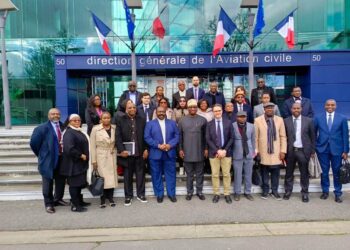The Nigerian Airspace Management Agency (NAMA) said it is addressing the poor radio communications in the country’s airspace, starting with the five international airports.
Speaking with aviation journalists in Lagos over the weekend, Mr. Tayib Odunowo, the Managing Director, of NAMA, agreed communication between the Air Traffic Controllers (ATCs) and pilots in the air within the country’s airspace had been a major problem confronting the agency in the past few years, but assured that the management was addressing this challenge.
Upgrading International Airports and Implementing AIS Automation
According to him, NAMA management had approved a contract for the upgrade of the five international airports in a bid to address the ATC-Pilot communications gap.
The airports are the Murtala Muhammed International Airport (MMIA), Lagos, Nnamdi Azikiwe International Airport (NAIA), Abuja, Mallam Aminu Kano International Airport (MAKIA), Port Harcourt International Airport (PHIA), Omegwa and Akanu Ibiam International Airport (AIIA), Enugu.
Odunowo also told journalists that the management had installed solar-powered transmitters in major airports and strategic stations in a bid to reduce communication failures.
Apart from this, he further stated that the management had set up a committee, comprising technical personnel, including pilots and ATCs that have identified key challenges in the poor communications gadget, assuring that whatever challenges faced in the industry would be resolved by the agency.
According to him, NAMA had further put in place an Aeronautical Information Service (AIS) automation process, which he said was ongoing.
All these, the Managing Director said were parts of the phase one process of the agency, stressing that after the completion of this stage, NAMA would move to phase two of the exercise, which he believed would address the challenge.
What he said
He said:
- “We started the power audit; you know when you want to diagnose a problem; you have to look at the symptoms before administering a drug. So, pretty much has been done in-house. We put a committee together, which is made up of engineers, people that own communication and operations, which are the user department.
- “So, they have identified key things, key deliverables that we have started working on to close the existing gap. One of them is power. So, immediately we rolled up solar-powered transmitters. What does that do? That bridges the gap in our communications.
- “The second is that we have deployed manpower. The communication issue we have is in our upper airspace. So, the third one is that we are doing what is called an Aeronautical Information Service (AIS) automation process, which is the backbone of everything we are talking about.
- “Everything that we are talking about now is going to ride on AIS automation and that process is ongoing currently. The contractor has promised that all five international airports will be operational.
The Controllers’ Perspective and the Call for Action
Poor radio communication has been a major challenge in the Nigerian airspace over the years with ATC at several forums challenging the Federal Government to declare a state of emergency on the issue.
The controllers, speaking through their parent body; Nigerian Air Traffic Controllers Association (NATCA), lamented that there are various poor communications between controller/pilot and controller/controller at the two area control centers in Kano and Lagos.
NATCA decried that the poor communication had remained a nightmare to both pilots and ATC, noting that its resolution would save the country from any form of embarrassment that may result from the current epileptic system.





















